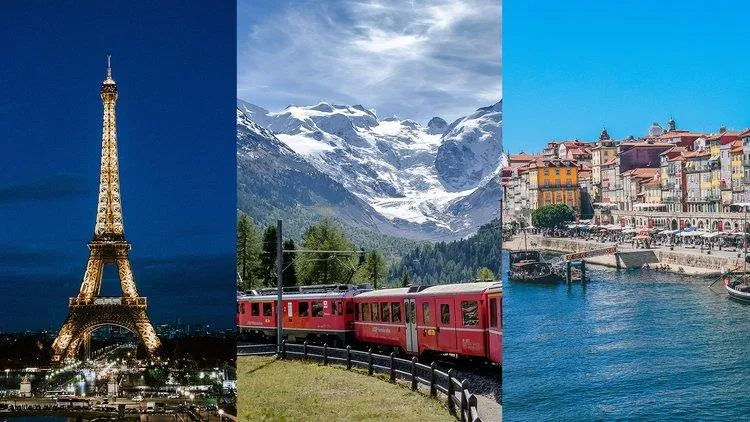Your Guide to Traveling from England to France
Wondering how to get from one side of the English Channel to the other? This article will cover all the different options for traveling from England to France and help answer any questions you may have about making the crossing. Whether you’re looking for the fastest route, most scenic journey, or budget-friendly choice, you’re sure to find the right way for your trip among these transportation methods.
Taking the Train
One of the most popular and straightforward options is taking the Eurotunnel shuttle train under the Channel. Eurotunnel runs trains between Folkestone in England and Coquelles near Calais in France. The journey only takes around 35 minutes each way, making it a very quick way to cross. Tickets can be booked online in advance through the Eurotunnel website.
From my experience, the trains run frequently throughout the day, every day of the week. You drive your vehicle onto the train in England, and it’s transported directly onto French soil without you having to disembark. The trains have WiFi and food/drink available for purchase on board. A couple drawbacks are that it can be pricey, especially for larger vehicles, and you’ll need to factor in extra travel time to reach Folkestone or Calais from other parts of the countries. But overall, it’s quite hassle-free.
Taking the Ferry
Another popular option for crossing between England and France is ferry travel. There are multiple ferry routes operating daily with sailings from Dover to Calais being one of the busiest in the world. P&O Ferries, DFDS, and Irish Ferries all run ferry services on this route with journey times averaging around 1-2 hours each way. Ferry crossings also operate between Portsmouth and Le Havre or Cherbourg with slightly longer travel durations.
Ferries can be a more scenic and relaxing way to make the crossing compared to the fast Eurotunnel shuttle trains. You’ll get views of the English Channel during the sailing. Many ferries have onboard amenities like shops, restaurants, lounges, and outdoor decks. However, ferry travel tends to be more expensive than the train and subject to delays depending on weather conditions.
Flying between the Countries
For those seeking the swiftest travel time between England and France, flying is obviously the quickest option, clocking in at only around 1 hour total travel time each way. The main international airports serving these routes are London’s Heathrow and Gatwick along with Paris Charles de Gaulle and Orly.

Low-cost airlines like EasyJet, Ryanair, and Vueling offer regular scheduled flights between airports all across both countries. However, flying can work out to be the priciest method when you factor in airport transfers, checked baggage fees, and the possibility of flight delays or cancellations throwing a wrench in your itinerary. Security queues at airports also eat up precious time. Moreover, air travel has a larger carbon footprint compared to ground transportation alternatives.
Driving Across the Channel Region
For those with more time and flexibility in their schedule, driving across the Channel region offers maximum independence and ability to stop wherever you please along the way. The Eurotunnel Le Shuttle car shuttle service is a popular choice and often less expensive than ferry crossings for single vehicles. Journey time is about the same as the passenger train at around 35 minutes.
An alternative is to embark on a scenic drive taking one of the ferry routes, like Dover to Calais. This allows enjoying views of the English countryside or French coastline en route. Be sure to plan sufficient time for potential ferry delays. Toll roads and petrol costs should also be budgeted for longer drives between destinations once across the Channel.
Coach Travel is an Affordable Option
Coach or bus services that allow loading vehicles onto their carriers are yet another viable choice. Companies like Eurolines operate daily international routes connecting major cities throughout the UK and France. The journeys take around 3-4 hours between London to Paris, for example.
Tickets booked online in advance work out quite cost-effective, especially for solo travelers. Many offer onboard wifi, power outlets, andeven reclining seats. However, trips aboard coaches involve more stops compared to direct rail or ferry crossings. Limited luggage storage can also be a consideration versus traveling by car.
Additional Factors to Consider
Beyond looking simply at transportation modes available, there are a few other aspects you’ll want to take into account when planning your cross-Channel trip from England to France:

Booking in Advance
It’s generally a good idea to purchase tickets or make reservations for rail, ferry, flight, or coach travel well ahead of your planned travel dates – especially during peak seasons. This helps secure the best prices which can rise closer to departure time.
Checking Travel Documents
Be sure to valid photo ID and any necessary visas or documentation required based on your citizenship when traveling between the UK and France/EU countries after Brexit. Passport validity rules also apply if flying rather than using the Eurotunnel.
Researching Travel Times
Know how long different transportation legs might take including transfers, border controls, and onboard duration. Things like ferry schedules lock-in departure and arrival slots versus faster rail or air options.
Planning Your Onward Journey
Have a plan for reaching your ultimate destination once across the Channel. For example, factoring in local/regional train, hire car pickup or arranging accommodation near arrival ports if continuing a driving route independently.
With care taken to consider the above items ahead of time from route selection to booking logistics, you’ll be well positioned to enjoy a smooth trip traveling between England and France using the transport option best suiting your needs. Happy travels across the Channel!
Travel Options from England to France
| Travel Method | Average Cost | Travel Time | Pros | Cons |
|---|---|---|---|---|
| Eurostar Train | £39-£160 roundtrip | 2 hours | Comfortable seating, wifi, power outlets, no driving | More expensive than other options, fewer departure times |
| Ferry | £30-£150 roundtrip per car | 2-4 hours depending on port | Bring your vehicle, convenient schedule | Extra cost if bringing a car, subject to weather delays |
| Drive | Cost of fuel for your vehicle | 2.5-4.5 hours depending on route | Flexibility, bring lots of luggage/cargo | Longer travel time than train, potential traffic |
| Bus | £30-£100 roundtrip | 4-6 hours | Inexpensive option, wifi on some routes | Longer travel time than train, less comfortable seats |
FAQ
-
How do I get from England to France?
There are a few different ways to travel from England to France. Basically, you can take a train, drive a car, or fly on a plane. The Eurostar train goes under the English Channel between London and Paris, and it takes around 2 hours. The Channel Tunnel is another option for driving a car across.

-
Do I need a passport to travel between England and France?
Yes, if you’re traveling by any method – whether it’s by train, car, or plane – you’ll need a valid passport to go from England to France. A passport shows your ID and citizenship so the border agents can approve your entry. It’s necessary due to both countries being in the European Union.
-
How much does the Eurostar train cost?
Eurostar train ticket prices vary depending on how far in advance you book and what type of ticket you get. Sometimes you can find deals for as low as £30-40 each way if you’re flexible with travel dates. However, last-minute tickets can cost £100-200 each way. Kids tickets are often cheaper too. Overall the Eurostar is usually the most affordable option.
-
Can I take my car on the Eurostar?
No, you cannot take your personal vehicle on the Eurostar passenger train. However, there is a shuttle service where they can transport your car through the Channel Tunnel while you ride on the train. The car shuttle has additional fees but it’s an option if you need your car in France. Otherwise you’d have to drive it over via ferry or Channel Tunnel driving route.
-
How long is the ferry ride from England to France?
It depends on which ferry route you take but most options take around 1-3 hours each way. Some of the main ferry crossings include Dover to Calais, which is only around 1 hour each way. Newhaven to Dieppe is slightly longer at around 3 hours. The ferry costs less than the Eurostar train too, as long as you factor in petrol or parking if driving your own car.
-
What is the easiest way for a family to travel?
For families with young kids, the Eurostar train is overall the simplest option. It’s a straight shot between London and Paris without needing to drive. You don’t have to deal with luggage or car seats. The ferry also works well as it allows kids to run around on board. However, be warned – ferries can get turbulent on rougher days! Driving provides flexibility but is more of a hassle with kids.
-
What type of ID do I need for travel between the UK and France?
Basically, to travel between the UK and France you’ll need a passport – it’s the only acceptable ID. Driving licences or national ID cards alone won’t suffice despite both countries being in the EU. When crossing borders by any method, be it by train, ferry or flying, you must present a valid passport to border agents upon entry and exit. It’s smart to always travel internationally with your passport for this reason.

